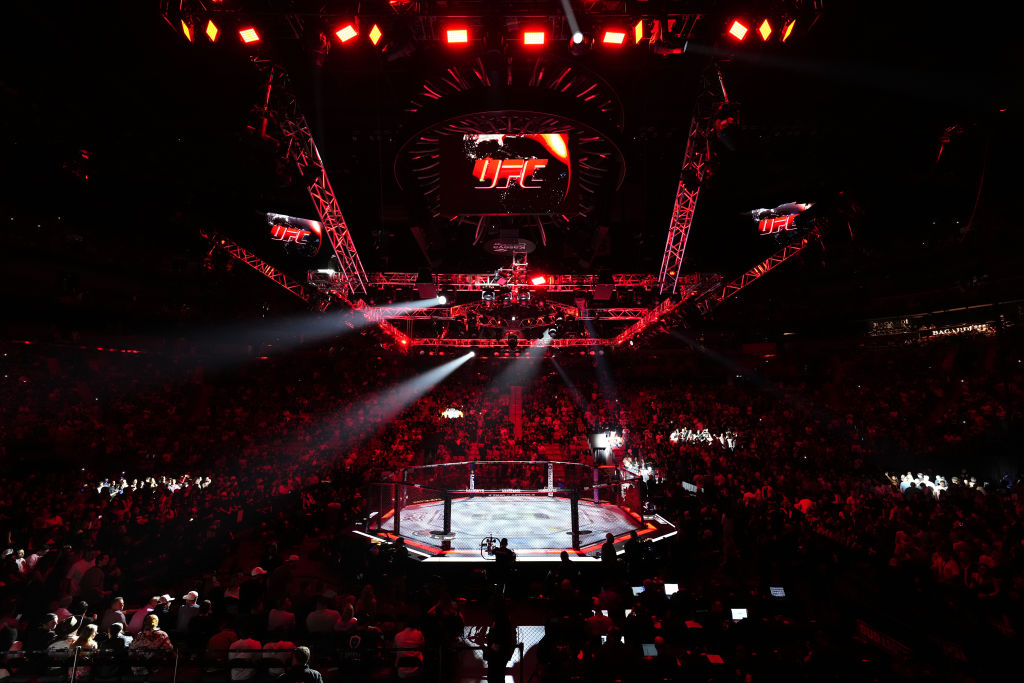UFC 300 PPV Event To Deploy 30 Cameras on the Octagon, AR Graphics
For shoulder programming, ESPN opts for three-camera production from Bristol
Story Highlights
The UFC celebrates its tricentennial pay-per-view event tomorrow night. UFC 300 will offer a much anticipated stacked fight card featuring three title bouts and a dozen current or former UFC champions competing at T-Mobile Arena in Las Vegas.
While UFC is producing the fight broadcast, ESPN is producing pre- and post-fight programming for its flagship network, ESPN+, and its other platforms.
“These centennial events have always done extremely well for the UFC,” says Tim O’Toole, SVP, event production, UFC. “It’s a big, momentous occasion. It’s not even a tentpole event — it’s much bigger than that.”
The UFC, which is overseeing in-house production of UFC 300, has 11 hours to load-in to the venue following the Vegas Golden Knights–Minnesota Wild regular-season game Friday night.

Headlined by three title fights, UFC 300 will take place at Las Vegas’s T-Mobile Arena on Saturday night.
The UFC acquired its own lightning, public-address, and projection systems, O’Toole explains, and also redesigned the Octagon to save construction hours for scenarios where there’s a time crunch. “We want to invest more of that time not on the load-in but on the rehearsal to make sure we are on our game.”
On the production side, according to O’Toole, PSSI Global Services will serve as its transmission vendor, ConCom is the outside production company assembling the event, and NEP is supplying two production trucks.
The UFC will introduce three enhancements normally not integrated into the broadcast, he adds. With Silicon Valley-based media-technology firm 4DReplay, the UFC has tested over the past four to six weeks and will mount 30 cameras on the apron of the Octagon pointing directly at the center to provide fans multi-angle highlights.
Augmented-reality graphics will also be on display throughout the telecast via UFC vendor Girraphic, a broadcast- and advertising-design agency. According to O’Toole, Girraphic will create a tracking system on the UFC’s Jitacam and give fight promotion access to about 35 animated themes that it can incorporate into the broadcast, most of which will be seen during the pay-per-view portion of the event.
PixMob’s LED wristband technology will engage fans in attendance through an in-house activation. Before the event, 20,000 bracelets will be placed on seats at T-Mobile Arena. They have been programmed to match fighters’ walk-out music for the night’s three final bouts, making it “the biggest part of the activation” with PixMob, O’Toole says.
“Once we get those fans in the seats as active participants in the event, which will transmit through the broadcast,” he explains, “it will be a great experience for those in attendance as well as for those watching at home.”
In total, the UFC will deploy 27 cameras for UFC 300, “slightly more than for UFC 299,” O’Toole notes, “but the same types.”
Like fight promotion, ESPN has thought about alternative production and broadcast models for scenarios like UFC 300. “Not everything has to come through a truck, and, with UFC, we take that fully to heart,” says Mark Mignini, senior manager, remote operations (studio), ESPN, adding that no mobile unit will be deployed for ESPN’s production around UFC 300. The broadcaster will use three cameras from Phoenix-based Crew West with fiber transmission to a control room in Bristol, CT.
“It’s almost like a truck in a box,” he says. “I hate the term down and dirty because it cheapens the product and it’s not meant that way. It looks great on-air, but we do a lot for less.”
ESPN targeted UFC 300 as “one of the main events” of 2024 that the broadcaster wants to cover from the studio-operations and production side, according to Mignini.
“We’re going all-in,” he says. ESPN’s traditional 20- x 20-ft. “heavyweight set,” designed by Massachusetts-based Mystic Scenic, will be situated on Toshiba Plaza outside T-Mobile Arena as part of a 40- x 40-ft. build. A smaller desk set will be located inside the venue, with both desks being live tomorrow.
With UFC 300, several ESPN studio shows will also be live from Las Vegas, including Good Guy/Bad Guy with Daniel Cormier and Chael Sonnen, UFC Road to 300, UFC Live, and Best Bets. In addition, throughout the week, there have been live spots with some of ESPN’s other studio programming, including FirstTake and SportsCenter.
As part of the ESPN production, Camera Operator Mike Shea will pilot a drone to enhance the outdoor coverage. “Think of it as our version of a blimp,” says Mignini, noting that he expects prepackaged edits along with live shots of the Vegas Strip. Since there are no restrictions outside, he has put a longer arm on the jib camera to obtain more beauty and crowd shots and give the at-home viewer a glimpse into the atmosphere along the downtown area and around the arena.
He estimates that ESPN will have eight to 12 staffers in a control room in Bristol, with 20-25 onsite in Las Vegas, including producers, technicians, and vendors but excluding on-air talent.
Early prelims and prelims begin at 6 p.m. ET and 8 p.m., respectively, across multiple ESPN platforms. The main card airs on ESPN+ pay-per-view starting at 10 p.m. Jon Anik will serve as play-by-play announcer with Cormier and Joe Rogan handling analyst duties. Megan Olivi will serve as sideline reporter.
